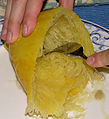Spaghetti squash
This article needs additional citations for verification. (January 2010) |
| Spaghetti squash | |
|---|---|
 Fruit of a yellow-skinned cultivar | |
| Species | Cucurbita pepo |
| Origin | North America and Central America |
| Nutritional value per 100 g (3.5 oz) | |
|---|---|
| Energy | 130 kJ (31 kcal) |
6.91 g | |
| Sugars | 2.76 g |
| Dietary fiber | 1.5 g |
0.57 g | |
0.64 g | |
| Vitamins | Quantity %DV† |
| Vitamin A equiv. | 1% 6 μg1% 64 μg |
| Thiamine (B1) | 3% 0.037 mg |
| Riboflavin (B2) | 1% 0.018 mg |
| Niacin (B3) | 6% 0.95 mg |
| Pantothenic acid (B5) | 7% 0.36 mg |
| Vitamin B6 | 6% 0.101 mg |
| Folate (B9) | 3% 12 μg |
| Vitamin C | 2% 2.1 mg |
| Vitamin E | 1% 0.13 mg |
| Minerals | Quantity %DV† |
| Calcium | 2% 23 mg |
| Iron | 2% 0.31 mg |
| Magnesium | 3% 12 mg |
| Manganese | 5% 0.125 mg |
| Phosphorus | 1% 12 mg |
| Potassium | 4% 108 mg |
| Zinc | 2% 0.19 mg |
| †Percentages estimated using US recommendations for adults,[1] except for potassium, which is estimated based on expert recommendation from the National Academies.[2] | |
Spaghetti squash — or vegetable spaghetti — is a group of cultivars of Cucurbita pepo subsp. pepo.[3] The fruit ranges from ivory to yellow/orange in color. The orange varieties have a higher carotene content. Its center contains many large seeds. Its flesh is bright yellow or orange. When raw, the flesh is solid and similar to other raw squash; when cooked, the flesh falls away from the fruit in ribbons or strands like spaghetti.
Preparation
Spaghetti squash can be baked, boiled, steamed, and/or microwaved.[4] It can be served with or without sauce, as a substitute for pasta. The seeds can be roasted, similar to pumpkin seeds.[4]
Nutrition
Spaghetti squash contains many nutrients, including folic acid, potassium, vitamin A, and beta carotene. It is low in calories, averaging 42 calories per 1-cup (155 grams) serving.[5]
Cultivation
Spaghetti squash is relatively easy to grow, thriving in gardens or in containers.[6]
The plants are monoecious, with male and female flowers on the same plant.[7] Male flowers have long, thin stems that extend upwards from the vine. Female flowers are shorter, with a small round growth underneath the petals. This round growth turns into the squash if the flower is successfully pollinated.
Spaghetti squash plants may cross-pollinate with zucchini plants.
-
Unprepared
-
Cooked
-
Prepared
-
Male flower
-
Female flower
-
Being sold at a Greengrocer in Japan
References
- ^ United States Food and Drug Administration (2024). "Daily Value on the Nutrition and Supplement Facts Labels". FDA. Archived from the original on 2024-03-27. Retrieved 2024-03-28.
- ^ National Academies of Sciences, Engineering, and Medicine; Health and Medicine Division; Food and Nutrition Board; Committee to Review the Dietary Reference Intakes for Sodium and Potassium (2019). Oria, Maria; Harrison, Meghan; Stallings, Virginia A. (eds.). Dietary Reference Intakes for Sodium and Potassium. The National Academies Collection: Reports funded by National Institutes of Health. Washington, DC: National Academies Press (US). ISBN 978-0-309-48834-1. PMID 30844154. Archived from the original on 2024-05-09. Retrieved 2024-06-21.
- ^ "USDA GRIN Taxonomy". Retrieved 31 January 2015.
- ^ a b How to Cook Spaghetti Squash
- ^ Squash, winter, spaghetti, cooked, boiled, drained, or baked, without salt
- ^ Spaghetti squash: a vegetable with a surprise inside
- ^ A Short Essay on Spaghetti Squash
External links
- Beany, A.H., P.J. Stoffella, N. Roe, and D.H. Picha (2002). "Production, fruit quality, and nutritional value of spaghetti squash". In J. Janick; A. Whipkey (eds.). Trends in new crops and new uses. Alexandria, VA: ASHS Press. pp. 445–448.
{{cite book}}: CS1 maint: multiple names: authors list (link)







